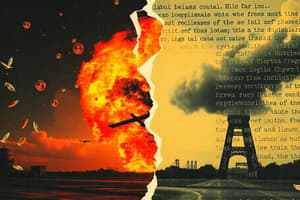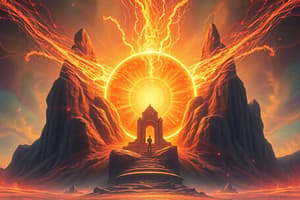Podcast
Questions and Answers
What does it indicate if the reaction energy Q is greater than zero?
What does it indicate if the reaction energy Q is greater than zero?
- The reaction is endothermal.
- The reaction is exothermal. (correct)
- The threshold energy is irrelevant.
- No energy is produced in the reaction.
What is the definition of threshold energy in nuclear reactions?
What is the definition of threshold energy in nuclear reactions?
- The kinetic energy of the outgoing particles.
- The minimum energy required for a reaction to occur. (correct)
- The maximum energy a nucleus can retain.
- The energy released after a reaction occurs.
In the mass-energy relation for nuclear reactions, what does the term -Q represent?
In the mass-energy relation for nuclear reactions, what does the term -Q represent?
- The kinetic energy of the outgoing particles.
- The combined energies of the residual and outgoing nucleus.
- The total mass of all particles involved.
- The energy liberated or required for the reaction. (correct)
If a reaction yields more kinetic energy in the outgoing particle than in the residual nucleus, what can be inferred about the outgoing particle angle θ?
If a reaction yields more kinetic energy in the outgoing particle than in the residual nucleus, what can be inferred about the outgoing particle angle θ?
What role does the kinetic energy Tx of the projectile particle play in the context of an endothermal reaction?
What role does the kinetic energy Tx of the projectile particle play in the context of an endothermal reaction?
Which of the following particles can be a projectile in a nuclear reaction?
Which of the following particles can be a projectile in a nuclear reaction?
Which type of nucleus is classified as a heavy nucleus according to its atomic mass number?
Which type of nucleus is classified as a heavy nucleus according to its atomic mass number?
What are the two general products of most nuclear reactions?
What are the two general products of most nuclear reactions?
Which of the following laws is not one of the conservation laws that nuclear reactions must satisfy?
Which of the following laws is not one of the conservation laws that nuclear reactions must satisfy?
What characterizes elastic Coulomb scattering?
What characterizes elastic Coulomb scattering?
What is the main feature of Rutherford scattering?
What is the main feature of Rutherford scattering?
In nuclear reactions, what happens to the total charge of the system?
In nuclear reactions, what happens to the total charge of the system?
How are incoming projectiles categorized in terms of mass?
How are incoming projectiles categorized in terms of mass?
What is the formula used to calculate Q for a nuclear reaction?
What is the formula used to calculate Q for a nuclear reaction?
In the calculation of Q for the reaction 27Al (α, γ) 31P, what is the value assigned to M_P?
In the calculation of Q for the reaction 27Al (α, γ) 31P, what is the value assigned to M_P?
What unit is used to express reaction cross sections?
What unit is used to express reaction cross sections?
Which of the following factors does NOT affect the reaction cross section?
Which of the following factors does NOT affect the reaction cross section?
What does the reaction rate measure in a nuclear context?
What does the reaction rate measure in a nuclear context?
In the example calculation for the reaction 15N (d, n) 16O, what is the value of Q?
In the example calculation for the reaction 15N (d, n) 16O, what is the value of Q?
How is the number of incident particles on the surface represented in the context of nuclear reactions?
How is the number of incident particles on the surface represented in the context of nuclear reactions?
Which term describes the thickness that strands of a substance have when considering reaction probabilities?
Which term describes the thickness that strands of a substance have when considering reaction probabilities?
What indicates an exothermal reaction based on the value of Q?
What indicates an exothermal reaction based on the value of Q?
Which expression correctly represents Q for an endothermal reaction?
Which expression correctly represents Q for an endothermal reaction?
If the value of Q for a reaction is negative, what kind of reaction is it?
If the value of Q for a reaction is negative, what kind of reaction is it?
What is the significance of threshold energy in endothermal reactions?
What is the significance of threshold energy in endothermal reactions?
In the calculations for Q, what does the term u signify?
In the calculations for Q, what does the term u signify?
What is the outcome when calculating Q for the reaction 168O 42α, 21d?
What is the outcome when calculating Q for the reaction 168O 42α, 21d?
What happens to the Q value in an exothermal reaction when energy is released?
What happens to the Q value in an exothermal reaction when energy is released?
For the reaction 209Bi p, d 208Bi, what is Q?
For the reaction 209Bi p, d 208Bi, what is Q?
How is the threshold energy calculated for the reaction involving Q?
How is the threshold energy calculated for the reaction involving Q?
What does the term $R_{TP}$ represent in the reaction study mentioned?
What does the term $R_{TP}$ represent in the reaction study mentioned?
In the optical model of nuclear reactions, what happens to absorbed particles?
In the optical model of nuclear reactions, what happens to absorbed particles?
Which approach is suggested for studying average behavior in nuclear reactions?
Which approach is suggested for studying average behavior in nuclear reactions?
In the formula $n \sigma_L = 4.61 \times 10^{28} \times 2 \times 10^{-24} \times 1 \times 10^{-4}$, what does $\sigma_L$ stand for?
In the formula $n \sigma_L = 4.61 \times 10^{28} \times 2 \times 10^{-24} \times 1 \times 10^{-4}$, what does $\sigma_L$ stand for?
Given the calculation of $R_{TP} = 1 - e^{-9.22}$, what does a value close to 1 imply?
Given the calculation of $R_{TP} = 1 - e^{-9.22}$, what does a value close to 1 imply?
What key component is necessary for a typical nuclear reaction study?
What key component is necessary for a typical nuclear reaction study?
In the context of nuclear reactions, what does the energy 'Q' typically represent?
In the context of nuclear reactions, what does the energy 'Q' typically represent?
Which of these is a characteristic of the optical model in nuclear reactions?
Which of these is a characteristic of the optical model in nuclear reactions?
What does the variable n represent in the context of nuclear interactions?
What does the variable n represent in the context of nuclear interactions?
What is the formula used to express the interaction cross-section σ?
What is the formula used to express the interaction cross-section σ?
How is the number of interacting particles ∆N from 0 to x represented mathematically?
How is the number of interacting particles ∆N from 0 to x represented mathematically?
What does the reaction rate R depend on in this context?
What does the reaction rate R depend on in this context?
What is the approximate expression for e^(-nσL) under the condition of small y?
What is the approximate expression for e^(-nσL) under the condition of small y?
What does the term flux (Φ) represent in the defined equations?
What does the term flux (Φ) represent in the defined equations?
How is the total number of interacting particles from 0 to x denoted?
How is the total number of interacting particles from 0 to x denoted?
What is the significance of the density (ρ) in the equation for n?
What is the significance of the density (ρ) in the equation for n?
What happens to the number of non-interacting particles as thickness increases?
What happens to the number of non-interacting particles as thickness increases?
Which equation correctly expresses the relationship for the number of non-interacting particles?
Which equation correctly expresses the relationship for the number of non-interacting particles?
Flashcards
Reaction Energy (Q)
Reaction Energy (Q)
The energy released or absorbed during a nuclear reaction, calculated using Einstein's mass-energy equivalence.
Threshold Energy (Tth)
Threshold Energy (Tth)
The minimum kinetic energy the projectile particle needs to initiate a reaction.
Exothermal Reaction
Exothermal Reaction
Nuclear reactions where energy is released. Q>0, energy is divided between the outgoing particle and the residual nucleus.
Endothermal Reaction
Endothermal Reaction
Signup and view all the flashcards
Kinetic Energy (T)
Kinetic Energy (T)
Signup and view all the flashcards
Projectile x
Projectile x
Signup and view all the flashcards
Target X
Target X
Signup and view all the flashcards
Products Y,L
Products Y,L
Signup and view all the flashcards
Residual nucleus Y
Residual nucleus Y
Signup and view all the flashcards
Outgoing particle y
Outgoing particle y
Signup and view all the flashcards
Conservation laws in nuclear reactions
Conservation laws in nuclear reactions
Signup and view all the flashcards
Coulomb scattering
Coulomb scattering
Signup and view all the flashcards
Elastic Coulomb scattering (Rutherford scattering)
Elastic Coulomb scattering (Rutherford scattering)
Signup and view all the flashcards
Threshold Energy
Threshold Energy
Signup and view all the flashcards
Q Value
Q Value
Signup and view all the flashcards
Q Value Formula
Q Value Formula
Signup and view all the flashcards
Endothermic Q value
Endothermic Q value
Signup and view all the flashcards
Exothermic Q value
Exothermic Q value
Signup and view all the flashcards
Threshold Energy Calculation
Threshold Energy Calculation
Signup and view all the flashcards
Threshold Energy Equation
Threshold Energy Equation
Signup and view all the flashcards
Significance of Threshold Energy
Significance of Threshold Energy
Signup and view all the flashcards
Q-value (Q)
Q-value (Q)
Signup and view all the flashcards
Exothermic Nuclear Reaction
Exothermic Nuclear Reaction
Signup and view all the flashcards
Endothermic Nuclear Reaction
Endothermic Nuclear Reaction
Signup and view all the flashcards
Reaction Cross Section
Reaction Cross Section
Signup and view all the flashcards
Nuclear Reaction Rate
Nuclear Reaction Rate
Signup and view all the flashcards
Impact Parameter (b)
Impact Parameter (b)
Signup and view all the flashcards
Probability of Reaction
Probability of Reaction
Signup and view all the flashcards
Nuclei Density (n)
Nuclei Density (n)
Signup and view all the flashcards
Nuclear Cross-Section (σ)
Nuclear Cross-Section (σ)
Signup and view all the flashcards
Flux (Φ)
Flux (Φ)
Signup and view all the flashcards
Number of Interacting Particles (ΔN)
Number of Interacting Particles (ΔN)
Signup and view all the flashcards
Reaction Rate (R)
Reaction Rate (R)
Signup and view all the flashcards
Approximate Reaction Rate
Approximate Reaction Rate
Signup and view all the flashcards
Absorption Ratio
Absorption Ratio
Signup and view all the flashcards
Thickness (L)
Thickness (L)
Signup and view all the flashcards
Density (ρ)
Density (ρ)
Signup and view all the flashcards
Q-value of a nuclear reaction
Q-value of a nuclear reaction
Signup and view all the flashcards
Projectile Particle
Projectile Particle
Signup and view all the flashcards
Target Nucleus
Target Nucleus
Signup and view all the flashcards
Products of a Nuclear Reaction
Products of a Nuclear Reaction
Signup and view all the flashcards
Study Notes
Nuclear Reactions
- Nuclear reactions involve changes within the atom's nucleus, often transforming elements. Energetic particles (from reactors, accelerators, or radioactive sources) striking bulk matter can initiate these reactions.
- Rutherford scattering, observed in the lab, provided the first evidence of atomic nuclei. This involved alpha particles from a radioactive source interacting with matter.
- A typical nuclear reaction is represented as: x + X → Y + y. Where 'x' is the projectile, 'X' is the target, 'Y' is the residual nucleus, and 'y' is the outgoing particle.
- The projectile (x) has a specific mass, kinetic energy, and direction (e.g., proton, neutron, alpha particle).
- The target (X) is stationary and can be a light or heavy nucleus, and its atomic weight (A) helps classify it (A < 40 is light, 40 < A < 150 is medium, A > 150 is heavy).
- The products (Y and y) are the result of the reaction and can be two or more particles.
Nuclear Reaction Conditions
- Nuclear reactions must satisfy conservation laws:
- Energy conservation: Total energy remains constant.
- Momentum conservation: Linear and angular momentum are conserved.
- Charge conservation: Total charge before and after is equal.
- Atomic mass conservation: Total number of protons and neutrons is constant.
Types of Nuclear Reactions
- Scattering: In this type, the projectile and outgoing particle are the same. There are two subcategories:
- Elastic scattering: Kinetic energy is conserved. The nucleus remains in its ground state. (e.g., Rutherford scattering)
- Inelastic scattering: Kinetic energy is not conserved (some is used to excite the target nucleus), and the nucleus is left in an excited state. (e.g., neutron scattering)
- Compound reaction: The projectile and target nucleus initially form a compound nucleus for a brief period, which then decays in multiple ways. No rule controls or dictates exactly how this compound nucleus decays.
- Fusion: Light nuclei combining to create a heavier nucleus.
- Fission: Heavy nuclei splitting into lighter nuclei.
- Other direct reactions: Direct reactions involve relatively instantaneous interactions where the projectile doesn't first fuse with the target nucleus.
Coulomb Scattering
- Coulomb scattering (sometimes Rutherford scattering) is used to study the electric charge distribution within the nucleus.
- It involves directing a beam of charged particles (e.g., alpha particles) at a target nucleus. The scattering of the particles is due to the electric interaction (Coulomb force) between the particles
- Analyzing the scattering data can reveal information about the charge distribution and the existence of the nucleus.
Reaction Cross Section
- Reaction cross section measures the probability of a nucleus interacting with incident particles.
- It's expressed in barns (1 barn = 10⁻²⁴ cm²).
- Dependence: The cross section depends on the energy of incident particles, the properties of the target nucleus, and quantum effects (e.g., resonance).
Reaction Rate
- Reaction rate = number of reactions per unit time (or second).
- Calculation requires factors like incident particle flux(Φ) (number of particles per unit time per unit area).
- The reaction rate depends on the cross-section (σ), the density (n) of nuclei in the target, and the thickness (L) of the target.
Energetics of Nuclear Reactions
- Q-value is the reaction energy. It's the difference between the initial and final masses (and thus energies).
- Exothermic: positive Q-value, energy is released.
- Endothermic: negative Q-value, energy is required.
- Threshold energy is needed in endothermic reactions to overcome the energy barrier.
Studying That Suits You
Use AI to generate personalized quizzes and flashcards to suit your learning preferences.




